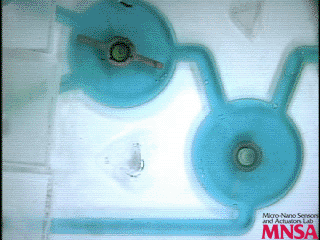Programmable autonomous micromixers and micropumps have been designed and realized via a merger between MEMS and microfluidic tectonics (µFT). Advantages leveraged from both fabrication platforms allow for relatively simple and rapid fabrication of these microfluidic components. Nickel (Ni) microstructures, driven by an external rotating magnetic field, are patterned in situ and serve as the microactuators in the devices. µFT permits in situ patterning through the use of a step-and-repeat fabrication process known as liquid-phase photopolymerization (LP³). LP³ is a polymer-based fabrication process tool that offers additional fabrication materials, including responsive hydrogels that expand and contract under different stimuli. Using pH- and temperature-sensitive hydrogels as clutches, autonomous micromixers and micropumps have been fabricated and tested that perform as closed-loop microsystems. The step-and-repeat fabrication process allows pre-programming of the system, like a programmable read-only memory chip, to be sensitive to a desired stimulus. Different Ni blade designs, and pH-sensitive hydrogel geometries and dimensions have been designed and tested to better ascertain their effects on micromixing efficiency and response times of hydrogels (related to the autonomous functionality), respectively. Temperature-responsive hydrogels have allowed for development of temperature-sensitive micromixers and micropumps with applications in areas demanding temperature control.
